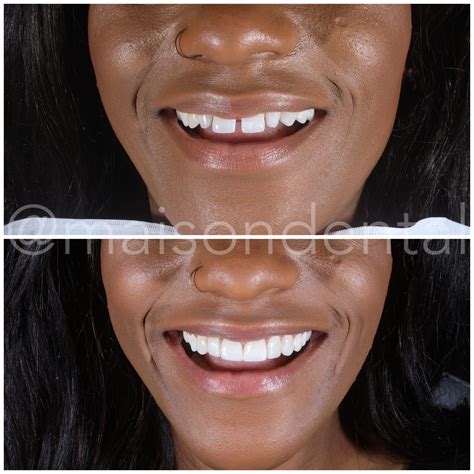Dental Bonding For Gap

When it comes to addressing gaps between teeth, dental bonding is a popular and effective solution. This cosmetic dentistry procedure involves the application of a tooth-colored resin material to the teeth, which is then shaped and polished to create a natural-looking smile. In this article, we’ll delve into the details of dental bonding for gap closure, exploring its benefits, the process, and what to expect.
What is Dental Bonding?
Dental bonding is a non-invasive and relatively inexpensive cosmetic dentistry procedure used to repair or improve the appearance of teeth. It involves the application of a tooth-colored resin material, which is then bonded to the tooth using a special light. This process can be used to fix a variety of cosmetic issues, including gaps between teeth, chipped or cracked teeth, and discoloration.
Benefits of Dental Bonding for Gap Closure
There are several benefits to using dental bonding to close gaps between teeth. Some of the most significant advantages include:
- Minimally invasive: Dental bonding is a non-surgical procedure that doesn’t require any removal of tooth structure.
- Quick and easy: The bonding process typically takes around 30 minutes to an hour per tooth, making it a great option for those with busy schedules.
- Affordable: Compared to other cosmetic dentistry procedures, such as veneers or implants, dental bonding is relatively inexpensive.
- Natural-looking results: The tooth-colored resin material used in bonding can be matched to the color of your surrounding teeth, creating a seamless and natural-looking smile.
- Reversible: If you’re not satisfied with the results, dental bonding can be easily reversed without damaging your teeth.
The Dental Bonding Process
The dental bonding process for gap closure typically involves the following steps:
- Preparation: Your dentist will start by cleaning and preparing the teeth that will be bonded. This may involve a mild etching solution to roughen the surface of the teeth.
- Application of bonding agent: A bonding agent is applied to the teeth, which helps the resin material adhere.
- Resin application: The tooth-colored resin material is then applied to the teeth, filling in the gap.
- Shaping and polishing: The resin material is shaped and polished to create a natural-looking smile.
- Final check: Your dentist will check the bonding to ensure it’s even and natural-looking, making any necessary adjustments.
Real-Life Examples
To illustrate the effectiveness of dental bonding for gap closure, let’s consider a few real-life examples:
- Case Study 1: A 25-year-old woman with a noticeable gap between her front teeth underwent dental bonding to close the gap. The result was a natural-looking smile that greatly improved her confidence.
- Case Study 2: A 40-year-old man with a gap between his teeth due to a missing tooth opted for dental bonding as a temporary solution until he could undergo implant surgery. The bonding provided a aesthetically pleasing solution that allowed him to smile with confidence while he waited for his implant.
Aftercare and Maintenance
To ensure the longevity of your dental bonding, it’s essential to practice good oral hygiene and maintenance. This includes:
- Brushing and flossing: Regular brushing and flossing can help prevent stains and damage to the bonded teeth.
- Avoiding stain-causing foods: Avoid consuming foods and drinks that can stain your teeth, such as coffee, tea, and red wine.
- Regular check-ups: Schedule regular check-ups with your dentist to ensure the bonding is still intact and to address any issues promptly.
Frequently Asked Questions
Is dental bonding painful?
+Dental bonding is a relatively painless procedure. You may experience some mild discomfort during the preparation stage, but this is typically minimal and temporary.
How long does dental bonding last?
+The lifespan of dental bonding can vary depending on several factors, including oral hygiene, diet, and the quality of the bonding material. On average, dental bonding can last between 5-10 years before needing to be replaced.
Can dental bonding be used to fix other cosmetic issues?
+Yes, dental bonding can be used to fix a variety of cosmetic issues, including chipped or cracked teeth, discoloration, and uneven teeth.
Is dental bonding suitable for everyone?
+Dental bonding may not be suitable for everyone, particularly those with extensive tooth decay, gum disease, or teeth that are severely damaged. Your dentist will be able to assess your suitability for dental bonding during a consultation.
How much does dental bonding cost?
+The cost of dental bonding can vary depending on several factors, including the location, the complexity of the procedure, and the dentist's experience. On average, the cost of dental bonding can range from $300 to $600 per tooth.
What are the advantages of dental bonding compared to other cosmetic dentistry procedures?
+Dental bonding has several advantages over other cosmetic dentistry procedures, including its minimally invasive nature, quick and easy application, and affordable cost. Additionally, dental bonding is a reversible procedure, making it a great option for those who are unsure about committing to a more permanent solution.
In conclusion, dental bonding is a effective and affordable solution for closing gaps between teeth. With its minimally invasive nature, quick and easy application, and natural-looking results, it’s no wonder why dental bonding has become a popular choice among those seeking to improve the appearance of their smile. By understanding the benefits, process, and aftercare requirements of dental bonding, you can make an informed decision about whether this procedure is right for you. Consult with a qualified dentist to determine if dental bonding is the best solution for your unique needs and smile goals.
